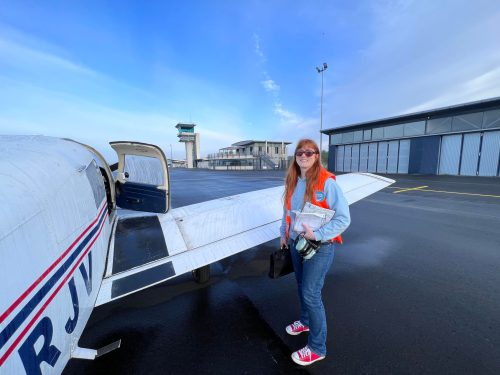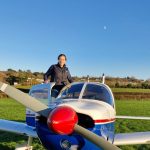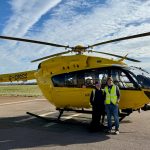Flight for Noor – flying a special mission from Rougham to Angers
We love hearing from our scholarship winners! Recently, Fiona Smith, winner of the 2021 624squadron.com scholarship, told us how she used her funds.
What a week it has been. With just shy of eight hours P1 over two days, I am now 25 minutes away from my SEP renewal by experience, I’ve visited three new airfields, and logged my longest flight to date. And, flown my QXC for CPL twice over. And, crossed an international border as P1. And, retraced the path of a brave lady in the process. All as part of my ‘special mission and flying adventure’ for my British Women Pilots’ Association 624squadron.com Scholarship.
In 2021 I was awarded a scholarship from the British Women Pilots’ Association (BWPA), inviting an aviation enthusiast to carry out a ‘special mission’. With the sponsor as 624squadron.com – a website remembering 624 (Special Duties) Squadron – I immediately sought to link my scholarship flight to the Special Operations Executive. That calls to my mind the name Noor-un-Nisa Inayat Khan. I first learned about Noor whilst working at the Commonwealth War Graves Commission. My favourite CWGC site is Runnymede Air Forces Memorial. I adore its quiet contemplative setting, of modernist cloisters in white stone, almost Nordic in nature. Being ex-Royal Air Force myself, it means a great deal to me to visit, and I’m amazed that I didn’t know of its existence until I worked for CWGC. It’s here that I first learned about Noor, and traced her name carved in stone with pride. Her own special mission took her to a field in France, code-named Indigestion. Located somewhere near the town of Angers, I was encouraged to discover there is a decent serviced airfield nearby, and a quick calculation suggested it was within reach of London within the day. My mission was clear – to fly from the south of England to Angers, lay a wreath for Noor, and fly back. As it happened, our actual flight has coincided with the 80th year of her leaving England.
I have flown in Italy, Greece and Canada, and done some gliding in Türkiye. It was in Canada that I first checked out on the PA-28, my aircraft of choice for the journey. I had not, however, ever done that right of passage that many new PPL holders like to do – fly to France. Exciting as that seemed, it was also a slightly frightening prospect. Undaunted, I stuck my application in for the BWPA scholarship, and as a throwaway consideration, mentioned I’d take a safety pilot along, a friend, former commercial pilot, and soon to be instructor.
I got the award! Now, planning began in earnest. Which included asking my pal, James McAndrew-Smith, “do you fancy having an adventure?” Naturally, he said yes. By the time our flight took place, he was a qualified and rapidly experienced flying instructor, providing the safety blanket of someone used to flying from the right-hand seat, and a comforting level of experience. However, the flight was to be mine. I brought to the party a wad of euros and a C in GCSE French. And, an enduring admiration for Noor.

Ready, set…!
Noor Inayat Khan was born in 1914, in Moscow. She was the daughter of Pirani Ameena Begum, an American poet, and Inayat Khan Rehmat Khan, an Indian teacher of Sufism. On her father’s side, Noor was descended from Mughal nobility. Sufiism and pacifism influenced Noor’s upbringing and outlook on life, and inspired her to support the war effort in any way she could. Noor’s family moved to Bloomsbury when she was an infant. Later, the family moved again to Paris. Noor studied child psychology and music at the Sorbonne. She wrote children’s stories and poetry, and took an interest in Buddhism.
When the Second World War began, Noor’s family returned to England. Noor joined the Women’s Auxiliary Air Force in 1940. Being fluent in French, with experience of living in France, Noor soon attracted the interest of the intelligence services. She joined the Special Operations Executive in February 1943, and was seconded to the First Aid Nursing Yeomanry.
She trained as a wireless operator, to work as an agent in France. Many reports from this time suggest she was thoroughly unsuitable – fragile, naïve, and clumsy. But her determination shone through, combined with her linguistic ability. She persevered.
Brave Noor was flown to France in a Lysander aircraft from RAF Tempsford, to a field near Angers, in June 1943. From there she was taken to Paris to work under cover, sending and receiving coded radio transmissions. Noor remained in Paris despite being urged to evacuate. By October 1943, she was betrayed and captured by the Gestapo. She gave no information away. In November 1943, she escaped from German intelligence custody, but was quickly recaptured and taken to Pforzheim in Germany, and kept shackled for ten months.
Noor’s final journey was to Dachau concentration camp in Germany, in September 1944. Along with four other female agents, she was executed. Her final word before being shot was “Liberté”. She has no known resting place, but there is a plaque to her now in Dachau’s hall of remembrance.
Noor was awarded the George Cross posthumously, and the Croix de Guerre. She is remembered throughout England: there is a Blue Plaque at her London home, a bust of her in Gordon Square, she is on a mural of heroic RAF women at the RAF Club in Piccadilly, and she is remembered by the Commonwealth War Graves Commission at Runnymede Memorial, for Air Force personnel with no known grave – Noor’s memory was not denied, because she is not ‘missing’, she is considered ‘there’. Noor is further remembered at her point of departure from England, one of several names at a memorial at Tempsford.
This flight would be the most significant milestone for me to date. In Canada, I flew something resembling a Qualifying Cross Country flight for my CPL prerequisite, a triangle across Manitoba from Steinbach South, to Brandon, to Gimli and back. Navigation can be tough in the Canadian Prairies, but the trade-off is limited airspace to deal with, with quiet airfields to visit. France doesn’t feel as busy as southern England can get, however there would be differences, and challenges, and the risk of getting stuck by weather. And of course, crossing the cruel sea. I bought French charts and researched the language expectations. I consulted SkyDemon’s French plates for Angers, Le Touquet, and a handful of potential diversions. Le Touquet have a reassuring and practical French RT guide. I’m a Francophile, and enthusiastic but novice Francophone. Reading the guide helped a great deal, and as with so much in aviation, the key was to be obvious, be safe, and be prepared.
The hotel was booked, Euros procured, aircraft reserved, and flight plans scrutinised. SkyDemon is a marvel and I am still very new to using it – in fact, this was also the first time I used my own SkyDemon on tablet, with SkyEcho. It’s the future! But I retain my love of charts, and I am anxious to keep my paper nav and whizz-wheel skills sharp.
James’s flight school is Skyward Flight Training of Rougham. Having flown only a couple of occasions from that historic field, it is heartbreaking to learn of its closure. It’s a little gem. Our plan was to depart Rougham, enter France at Le Touquet, and continue to Angers. We would lay a wreath, stay the night, and return to the UK via Southend, then on to Rougham.

James and I, my friend and fellow pilot
I stayed with a friend in Elmswell the night before, and met James bright and early on a Monday morning. The weather was in our favour and improving. However, we needed to fuel up at Earls Colne. This was an unexpected delight for me, as it was a new airfield. Tummy now full, our course was set for Le Touquet. Southend activated our flight plan, and we transited the zone. Southend is special to James and I, as it is where we both gained our PPLs. With the airport in sight, James produced from his pocket the small tribute we picked up at our instructor Derek Bidwell’s funeral in 2021. Zone transit is not a time to cry!
Kent was in sight, and familiar territory to both of us. Picking up the Dover VOR and talking to London, soon there was sea below us. Suddenly, the picture looked mildly terrifying. The horizon bled into murk, grey upon grey. No land in sight. Instinctively, I thought I’d lost VFR, and then rationalised that the Channel even at its narrowest point is beyond our current visibility. It would take some minutes to see land again, and VOR would be crucial. I’ve no desire to sound dramatic, but it was deeply unnerving. We had briefed on crossing the channel, and in the event of ditching, agreed James would be best to take control. It can be upsetting for non-pilots to hear us consider these things, but consider them we must. We also crossed at the narrowest point to minimise our time over sea. Soon enough Cap Gris-Nez of Calais emerged from the mire, and we were preparing to land in a new country.
Having prepared for French RT, I checked my handy crib sheet. We had reason to believe that it was English now, French later. With relief, our call to Le Touquet was answered in crystalline English RT. I’d seen Étaples on the charts and maps but failed to connect it with the CWGC. To our delight as we flew over we could see the war graves arranged in a simple Union Flag effect. Another serendipitous connection on an adventure that was progressing well.
Le Touquet was friendly and efficient. It was amusing to pass through customs as two giddy aircrew, and if we must have French stamps in passports, it’s so much nicer to have rare ports in there. Having paid our landing fee, we got a visitor stamp in our logbooks. We couldn’t hang around, so we set off again, forewarned that now it was time for French RT. We listened and heard calls in both French and English, and soon we’d be talking to Lille anyway.
We set course for Angers, listening to chatter in French and English. I began to fool myself into thinking that I could probably manage French RT calls. One eventuality we had discussed was, if I was having to exercise my Francophone muscle (atrophied, and barely there at all) James would take control. We climbed to ensure we avoided the nuclear reactors at Dieppe, dropping down again to remain visual. We meandered down past Rouen and towards Le Mans. My father and brother, both race car drivers and racing enthusiasts, will be there in June to watch 24 Heures du Mans.
Soon, we were talking to Angers and waiting for it to pop into view. It appeared all at once, beautifully clear, below us a lovely little airport and active club. We’d heard plenty of gliders chatting on our way down, and as glider pilots ourselves kept a look out, anxious to be safe and respectful towards our engineless comrades. Angers gliders fly their circuits to the south, powered to the north, so we joined downwind into an empty pattern. After the best landing of the day (this flying thing seeming more natural by the minute) we taxied for fuel and admin. Angers ops were lovely, and our taxi driver had been waiting patiently to whisk us into the town. We were ecstatic – after the trip we had been planning for weeks, we were now in Angers, France.

Bonjour from France!
We checked in, and walked in the pleasant evening sun towards the town war memorial at Place du Général Leclerc, past a boisterous but friendly demonstration outside the hôtel de ville. Away from the hubbub, I laid my simple lavender wreath for Noor, and read a Sufi prayer for peace: “Send Thy peace O Lord, our Father and Mother, that we Thy children on Earth may all unite in one family.”
We dined and prepared for an early morning start, to make the most of the light and the potential for bad weather. On rising the airfield was misty, but we guessed correctly it would burn off. Either way we prepared to go as soon as conditions suited. Customs on departing was in the fire station, with two visiting officers and a briefcase serving as the border. One more interesting stamp! The weather on return was smoother and we were able to get a bit more height. Crossing the channel at 6000 ft felt safer than yesterday’s scoot across at 3000 ft, and it was reassuring to actually see the Kent coast this time. Before long we were talking to London and crossed the invisible border into the UK, taking the opportunity to graze the Battle of Britain memorial at Capel-le-Ferne.
We cleared customs through Southend, which is a special airport for us both. I had enjoyed the flight back, but, it was long. It was reassuring to have James as back up, and I could feel my capacity beginning to wane. Safely down in Southend, we made time to call in at Seawing, where Derek Bidwell had taught us, and James called in next door at Southend Flying Club who had taught his FI course. The only thing now was to return to Rougham (and collapse into a little heap). We had to get moving soon, before a large chunk of East Anglia was closed to us for a flypast practice.
Back at Rougham, elated, tired, sweaty and happy, we debriefed and handed our trusty PA-28 back. I’m not sure if I’ll be able to visit Rougham again before it closes, and that is a sad thing. We flew past Wethersfield, our gliding school home for so many years, and that has gone also. But overwhelmingly, I feel lucky to have had this opportunity to do an ambitious flight, going beyond what I have done before. We also returned home, as Noor could not.
In the building up to my BWPA scholarship flight, I have found the support of Resilient Pilot invaluable. I have just finished a year-long CAAi funded Resilience Development Programme, which has helped me continue my development outside of the cockpit. My thanks go to the British Women Pilots’ Association for their support in this adventure, and to 624squadron.com for sponsoring the scholarship. Thanks of course to James for his company and support. This flight is another step along my commercial flight journey, and provided lessons along the way. It’s also served to demonstrate to me what I am capable of. I feel immensely proud.
Fiona Smith






